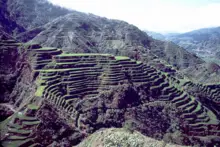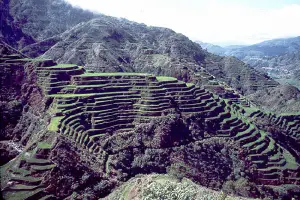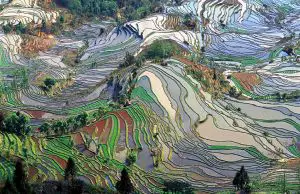Banaue Rice Terraces
| Rice Terraces of the Philippine Cordilleras* | |
|---|---|
| UNESCO World Heritage Site | |
 Banaue Rice Terraces, Ifugao Province, Philippines. | |
| State Party | |
| Type | Cultural |
| Criteria | iii, iv, v |
| Reference | 722 |
| Region** | Asia-Pacific |
| Inscription history | |
| Inscription | 1995 (19th Session) |
| Endangered | 2001- |
| * Name as inscribed on World Heritage List. ** Region as classified by UNESCO. | |
Te Banaue Rice Terraces (Tagalog: Hagdan-hagdang Palayan ng Banaue) are 2000-year old terraces that were carved into the mountains of Ifugao in the Philippines by ancestors of the Batad indigenous people. The Banaue terraces are part of the Rice Terraces of the Philippine Cordilleras, ancient sprawling man-made structures from 2,000 to 6,000 years old. They are found in the provinces of Apayao, Benguet, Mountain Province and Ifugao, and are a UNESCO World Heritage Site.
Description
The Rice Terraces are commonly referred to as the "Eighth Wonder of the World". It is commonly thought that the terraces were built with minimal equipment, largely by hand. The terraces are located approximately 1500 meters (5000 ft) above sea level and cover 10,360 square kilometers (about 4000 square miles) of mountainside. They are fed by an ancient irrigation system from the rainforests above the terraces.
Banaue, Ifugao
Banaue is a 4th class municipality in the province of Ifugao, Philippines. According to the 2000 census, it has a population of 20,563 people in 3,952 households. It is widely known as the site of the Banaue Rice Terraces.
Banaue Rice Terraces
Sometimes called the "Eighth Wonder of the World", the Banaue Rice Terraces begin at the base of the mountain range and extend several thousand feet upwards. The terraces have been named a Unesco World Heritage Site. It is said that their length, if put end to end, would encircle half of the globe. Built 2,000 years ago, the rice terraces manifest the engineering skill and ingenuity of the sturdy Ifugaos. They are irrigated by means of mountain streams and springs that have been tapped and channeled into canals that run downhill through the rice terraces.
The rice terraces once stretched northeast to Cagayan and as far south as Quezon. However they are now slowly being abandoned and showing signs of deterioration. A severe 1990 earthquake damaged some of the terraces' irrigation systems, while El Niño triggered droughts that led giant earthworms to erode the terraces' soil. Furthermore, the rice variety most suited to the area's cool climate is not a high-yielding crop; because it takes so long to mature, some Ifugao families have abandoned their land in the rice terraces in favor of land that reaps faster rewards.
An Ifugao Terraces Commission was created in 1994 but has since been superseded by the Banaue Rice Terraces task force, which was closed in 2002.
Barangays
Banaue is politically subdivided into 18 barangays.
|
|
| |||||

In agriculture, a terrace is a leveled section of a hilly cultivated area, designed as a method of soil conservation to slow or prevent the rapid surface runoff of irrigation water. Often such land is formed into multiple terraces, giving a stepped appearance. The human landscapes of rice cultivation in terraces that follow the natural contours of the escarpments like contour plowing is a classic feature of the island of Bali and the Banaue Rice Terraces in Benguet, Philippines. In Peru, the Inca made use of otherwise unusable slopes by drystone walling to create terraces. This form of land use is prevalent in many countries, and is used for crops requiring a lot of water, such as rice. Terraces are also easier for both mechanical and manual sowing and harvesting than a steep slope would be.
Natural terracing, the result of small-scale erosion, is formed where cattle are grazed for long periods on steep sloping pasture. Sometimes, as a Glastonbury Tor, the result is regular enough to give an impression of archaeological artifacts.
From its origins in agriculture the practice of formally terracing a sloping site evolved in gardening. The Hanging Gardens of Babylon could have been built on an artificial mountain with stepped terraces like those on a ziggurat. At the seaside Villa of the Papyri in Herculaneum, the villa gardens of Julius Caesar's father-in-law fell away giving pleasant and varied views of the Bay of Naples.
Terraces were also methods of soil conservation farming for the Inca. They used a system of canals and aqueducts, and made the water flow through dry land and helped them be fertile lands.
The Incas constructed the terraces on the slopes of the Andes mountains. They cut step-like ledges into the mountainside, so they could be used as field, where they planted crops. Using terraces also stopped the rain from washing away the soil. This technique was so successful, it is still used in the Andes Mountains.
In old English, a terrace was also called a lynch and there is a fine example of a Lynch Mill in Lyme Regis, for which the water arrives via a river ducted along a terrace. This set-up was used in steeply hilly areas in the UK.
Local Peoples
Locals to this day still tend to the rice and vegetables on the terraces, although more and more younger Ifugaos do not find farming appealing, often opting for the more lucrative hospitality industry generated by the Rice Terraces. The result is the gradual erosion of the characteristic "steps", which need constant reconstruction and care.
Notes
ReferencesISBN links support NWE through referral fees
- Beyer, Otley. 1955. The origin and history of the Philippine rice terraces. Quezon City: Published by the National Research Council of the Philippines, University of The Philippines.
- Medina, Susan Calo. 1989. Terraces of Banaue. Los Angeles, CA: Philippine Expressions. OCLC 43042776.
- Medina, Carlos R. 2003. Understanding the Ifugao rice terraces. Baguio City, Philippines: Saint Louis University, Cordillera Research and Development Foundation. OCLC 62073906.
- Wackernagel, Frederick W. 1985. Rice for the terraces: cold-tolerant varieties and other strategies for increasing rice production in the mountains of Southeast Asia. Thesis (Ph. D.)—Cornell University, Jan., 1985. OCLC 48438516.
- World Heritage Sites, and Schlessinger Media. 2005. Vietnam & the Philippines. Wonders of the Asian world. Wynnewood, Penn: Schlessinger Media. ISBN 9781417103423.
External links
- UNESCO World Heritage Site Link. Retrieved July 6, 2008.
- Philippine Standard Geographic Code. Retrieved July 6, 2008.
- 2000 Philippine Census Information. Retrieved July 6, 2008.
- More photos and information on Banaue, Ifugao. Retrieved July 6, 2008.
- The Julia Campbell Agroforest Memorial Eco-Park in Asipulo, Ifugao. Retrieved July 6, 2008.
| |||||||
Credits
New World Encyclopedia writers and editors rewrote and completed the Wikipedia article in accordance with New World Encyclopedia standards. This article abides by terms of the Creative Commons CC-by-sa 3.0 License (CC-by-sa), which may be used and disseminated with proper attribution. Credit is due under the terms of this license that can reference both the New World Encyclopedia contributors and the selfless volunteer contributors of the Wikimedia Foundation. To cite this article click here for a list of acceptable citing formats.The history of earlier contributions by wikipedians is accessible to researchers here:
The history of this article since it was imported to New World Encyclopedia:
Note: Some restrictions may apply to use of individual images which are separately licensed.



